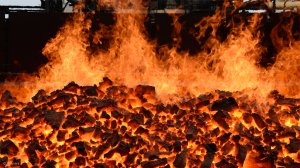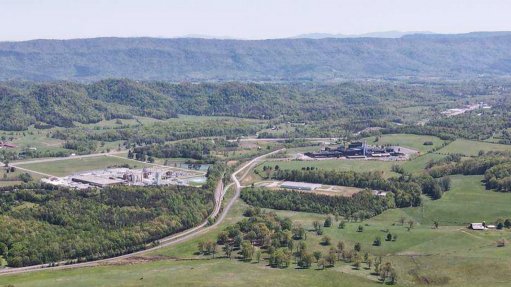Global coal glut prompts coal miners to chant ‘cut, cut, cut’
TORONTO (miningweekly.com) – In the face of stubbornly low coal prices and a global supply glut, struggling North American coal producers are grappling with stalled demand growth and increasingly strict environmental regulations, while simultaneously navigating congested export corridors to critical markets across the Pacific.
Speaking to Mining Weekly Online from New York on Friday, Wood Mackenzie commodities research analyst Joe Aldina sketched a rather gloomy scenario for the global coal industry, pointing to only a few potential positive market catalysts in the near term.
The global coal industry, comprising both electricity-generating thermal coal and steelmaking metallurgical coal, is not in great shape at the moment, he conceded. This was mainly owing to the significant oversupply of coal, which was exacerbated by a slower-than-expected growth in demand, especially from China, which was weighing heavy on the industry.
Metallurgical coal prices had already been sliding continuously for four years, from when the 2010/11 Australian floods took place and shut down its coal industry for months. The ensuing higher prices sparked several new coal start-ups to enter the market, which was today one of the significant contributors to the supply overhang.
Coal Association of Canada (CAC) president Ann Marie Hann agreed, saying that about half of the global coal output at current pricing was being produced at a loss.
“Until a global rebalance between demand and supply takes place and the global economy rebounds, the coal industry will unfortunately probably see some more bad news over the coming months,” she told Mining Weekly Online from Calgary.
Thermal coal prices had fallen in recent years from about $190/t in mid-2008 to $75/t this year. Metallurgical coal had dropped from a high of more than $300/t in late 2011 to less than $120/t.
In the US, metallurgical coal output was, in general, at the high end of the cost curve. “The US, which had traditionally been a swing-supplier, was hit particularly hard by the low prices,” Aldina noted.
However, Canadian coal producers fared only slightly better than their US rivals, thanks, in large part, to the bulk of metallurgical coal exports originating from Teck Resources’ British Columbia mines. He added that the company was known for its lower cost profile, ensuring that it remained cash-flow positive.
This, however, was not the case for other producers, especially in Australia. Aldina pointed out that despite Australia not being the only bad actor in the current market glut, the reason for its high output stemmed from the 2011 floods.
In the aftermath, many coal producers invested in new infrastructure and project build-outs, the cost of which needed to be paid back now. These, compounded by several companies operating under take-or-pay contracts, prohibited them from idling unprofitable mines.
CUT, CUT, CUT
Aldina stressed that the current overriding theme in the global coal industry was to cut costs, or to cut output to balance it with the reduced demand and low prices, in both the thermal and metallurgical coal space.
“Companies’ top lines have by now not been growing for four years, prompting them to take a serious hard look at their operations. The mantra is ‘cut, cut, cut’,” he said.
Indeed, many North American operators had idled unprofitable mines. Alpha Natural Resources last month joined a slew of other coal miners such as Consol Energy, Walter Energy and Patriot Coal that had, in recent months, either given notice to idle mines, or had shuttered operations, as they battled stubbornly low coal prices.
Hann noted that the industry’s struggles were exemplified by two significant Canadian development projects having been placed on the back burner. Teck said that it would defer restarting the Quintette coal mine, in north-east British Columbia, which had the potential to produce between three-million tonnes and four-million tonnes of steelmaking coal a year, until market conditions had improved.
Australia’s Coalspur had also delayed its $478-million Vista project, in Alberta, which had the potential to become Canada’s largest thermal coal mine, while Walter Energy had idled three mines.
Aldina explained that despite there having been flickers of optimism earlier this year for increased demand for thermal coal in 2014, owing to the bitterly cold North American winter of 2013/14 having forced utilities to run down their coal inventories to critical levels, a cooler summer had wiped out this optimism, as utilities did not restock with the anticipated higher volumes. He noted that utilities would be restocking ahead of the oncoming winter, but not with the previously expected urgency.
Another factor keeping demand low was the congested rail capacity in the US, especially around the Powder River basin.
In the US, the Environmental Protection Agency’s new Mercury and Air Toxics Standards and Clean Power Plan for thermal power plants would also impact on the thermal market; however, there still remained a lot of uncertainty as to the full extent with which the proposed clean air regulations would impact on the coal-mining industry.
Hann noted that Canada had in 2012 announced similar stricter emissions control rules that would take effect on thermal coal operations from 2019. Almost all of Canada’s thermal coal output originating from Saskatchewan, New Brunswick and Nova Scotia, as well as from Alberta, was consumed domestically for coal-fired power generation.
“The new legislation requires the coal-fired plants to adopt carbon capture technology, none of which had yet been commercially proven. This would probably [result in] at least five units com[ing] off line at that time.
“Owing to most of Canada’s thermal coal mines being near the thermal plants and having been designed to only supply coal to the plants, the door would be closed to them to later sell thermal coal elsewhere, owing to the required infrastructure simply not existing, nor being worthwhile to invest in at current prices, ” she stated.
INFRASTRUCTURE SQUEEZE
According to the CAC, about 80% of Canada’s coal exports were shipped through British Columbia, mainly owing to the vast amount (90%) of Canada’s coal deposits being located in western provinces. In 2011, with $7.1-billion in coal exports, British Columbia coal exports were a significant contributor to the province’s export activity, making up 21.8% of total exports. Shipments of coal increased 10% from 22.3-million tonnes in 2010 to 24.5-million tonnes in 2011, with the value of coal exports growing by 35% from $5.3-billion to $7.1-billion.
Last year, the western-based Westshore Terminals, Neptune and Ridley Terminals saw more than $1-billion invested in improvements to terminal efficiency and capacity. This included adding more than 20-million tonnes in coal-handling capacity.
US port infrastructure, however, was struggling to keep pace. Frustrated by the lack of capacity, Powder River basin coal producers were turning to Vancouver-area terminals and even Prince Rupert, in the hopes of securing export capacity. They were often turned away, the result of Port Metro Vancouver’s coal exports climbing 46% in 2011, as US West Coast terminal plans stalled.
Amid the constrained access to the West Coast export infrastructure, US coal miner Cloud Peak Energy got a break last month, when it inked a deal with Westshore, in Vancouver, to increase its export allocation by about two-million tons, lifting the miner’s expected 2015 Asian exports to between 6-million tons and 6.5-million tons, compared with the between 4-million tons and 4.5-million tons currently forecasted for 2014.
However, coal operators in the Powder River basin had a setback last month when Australia's Ambre Energy’s proposed $240-million coal transfer and loading project at the Port of Morrow on the Columbia river was unsuccessful in its permit application filed with the Oregon Department of State Lands. The Coyote Island Terminal was to transport up to 8.8-million tons of coal a year by train from Montana and/or Wyoming to Boardman, where it would have been transferred by barge down the Columbia river to Port Westward and loaded onto ships bound for Asia.
PRICE CATALYSTS
Despite the doom-and-gloom scenario, Aldina pointed to several factors that could push coal prices higher in the near term.
Potential catalysts included a potential strike at India’s State coal miner Coal India. More than half of India's thermal power plants, which source most of their coal from Coal India, only had enough stock to last for less than a week, which could bode well for the thermal coal market.
The Indian Supreme Court was also looking into the fate of 200-odd coal mine blocks allocated to several companies over the past decade that might be cancelled and given to Coal India, which would also potentially impact on output in the country in the near term.
Further, any disruptions in coal moving between Russia and the European Union, owing to geopolitical tension and sanctions, could spur positive price movements, while fighting in the Ukraine may cause an uptick in imports to that country, potentially driving prices upward.
However, Colombia had seen strong production growth this year despite some export interruptions and Aldina noted that the availability of Colombian supply might, in fact, mute the price response spurred by Russia or the Ukraine.
ACTIVE LOBBYING
Hann stated that some of the most critical issues the CAC was dealing with currently were to lobby provincial and federal governments to streamline their project approval processes in general.
“Many companies start projects owing to recognising a particular window of opportunity having opened up for them. However, should the regulatory processes take too long to complete, the companies would lose out on the opportunity, which also translates into missed opportunities for the local and federal economies,” she highlighted.
To this end, the CAC was currently having specific dialogues with the British Columbia and Alberta governments.
She also noted that the CAC was engaged in helping Canadians understand what an important role coal played in the Canadian economy. In 2012, it contributed to about 40 000 jobs, paid about $3-billion in wages and added about $5-billion to the nation’s gross domestic product. It also added about $700-million in taxes and royalties to government coffers.
“The coal industry is not dying. The industry is facing challenges, but the circumstances aren’t entirely new. We are in a cyclical downturn and it is bound to bounce back.
“Companies are currently repositioning themselves and if they survive this, would be positioned to take advantage of the eventual upswing, as coal will continue to act as a core commodity across the globe for decades to come,” Hann concluded.
Comments
Press Office
Announcements
What's On
Subscribe to improve your user experience...
Option 1 (equivalent of R125 a month):
Receive a weekly copy of Creamer Media's Engineering News & Mining Weekly magazine
(print copy for those in South Africa and e-magazine for those outside of South Africa)
Receive daily email newsletters
Access to full search results
Access archive of magazine back copies
Access to Projects in Progress
Access to ONE Research Report of your choice in PDF format
Option 2 (equivalent of R375 a month):
All benefits from Option 1
PLUS
Access to Creamer Media's Research Channel Africa for ALL Research Reports, in PDF format, on various industrial and mining sectors
including Electricity; Water; Energy Transition; Hydrogen; Roads, Rail and Ports; Coal; Gold; Platinum; Battery Metals; etc.
Already a subscriber?
Forgotten your password?
Receive weekly copy of Creamer Media's Engineering News & Mining Weekly magazine (print copy for those in South Africa and e-magazine for those outside of South Africa)
➕
Recieve daily email newsletters
➕
Access to full search results
➕
Access archive of magazine back copies
➕
Access to Projects in Progress
➕
Access to ONE Research Report of your choice in PDF format
RESEARCH CHANNEL AFRICA
R4500 (equivalent of R375 a month)
SUBSCRIBEAll benefits from Option 1
➕
Access to Creamer Media's Research Channel Africa for ALL Research Reports on various industrial and mining sectors, in PDF format, including on:
Electricity
➕
Water
➕
Energy Transition
➕
Hydrogen
➕
Roads, Rail and Ports
➕
Coal
➕
Gold
➕
Platinum
➕
Battery Metals
➕
etc.
Receive all benefits from Option 1 or Option 2 delivered to numerous people at your company
➕
Multiple User names and Passwords for simultaneous log-ins
➕
Intranet integration access to all in your organisation





















